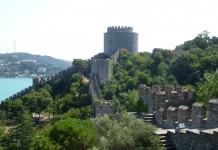
For many, Pablo Picasso (1881-1973) is the preeminent artist of the twentieth century. In addition to being active and prolific, he was able to constantly change and reinvent himself throughout a variety of periods. Picasso was also immensely talented in that he worked with a large selection of media, not limiting himself to only oil and canvas. Residents of Istanbul are lucky to be able to see selections from Picasso’s immense oeuvre at the Pera Museum as part of their exhibition, “Picasso: Engravings and Ceramics from the House of His Birth”, which runs until April 20.
The exhibition, which is on the third floor of the Pera, is sponsored by the Picasso Foundation in Malaga, Spain, the Spanish Embassy, and the Cervantes Institute. The exhibition is organized around certain key themes: reworkings of Cranach and Delacroix, family matters, the departure of the knight, convulsive beauty, women, and the call of the classical era. Many of these are themes that Picasso explored throughout his long career.
Every artist is influenced either directly or indirectly by the artists that come before him or her. In Picasso’s case this is evidenced by his reworkings of the paintings of Lucas Cranach and Eugene Delacroix. One of the strengths of the exhibit is that it shows Picasso’s evolution as an artist and how he modifies or otherwise changes the original painting or inspiration into something truly his own. The curators show this process through a series of pieces of the same topic. You can see how the figures change shape and form and, over a series of progressions, become more cubistic.
Family was an important part of Picasso’s life and he took the opportunity to depict his children in his artwork, which is very playful. One of his pieces exhibited here is entitled “Francoise, Claude, Paloma: Reading and Games II”. It is also important to note that a photograph of Picasso as a young child welcomes you into the exhibit.

Ideas of chivalry, knights and heroism go back to before Cervantes’ Don Quixote in Spanish history and art, and this influence also manifested itself in Picasso’s work as well. You can see these themes clearly in his work entitled, “The Knight and the Squire” as well as “The Departure”, both done with pen on zinc and both of which date from the 1950s. The curators suggest than Picasso also used many of these ideas of heroism in his “Massacre in Korea”, which dates from the same period as these works.
Depictions of women and beauty take up a large part of Picasso’s oeuvre and this theme also is sampled in this exhibit. One section of pieces shows classical nude portrayals of women becoming more abstract and cubistic over a series of paintings, only to focus and change to line and shape formations. Here you can see the geometric and mathematical underpinnings of Picasso’s art.
The final corridor of the exhibition highlights Picasso’s reworkings and homages to classical themes in his art. An important image here is that of Pan, the ancient Greek god of nature and the wild, and Bacchus/Dionysus, who traditionally has represented wine and unconstrained hedonism. You can see depictions of these ancient figures in the art of this section. You get the sense that Picasso perhaps identified with these figures of freedom, independence, creativity, and passion throughout his life and art.
In addition to the exhibition on Picasso, Pera is currently hosting an exhibition on contemporary Nordic glass art entitled, “Aurora” which is shown on the top two floors of the museum. For a chance to see just a small sample of the vast imprint Picasso made on twentieth century art, make sure you see “Picasso: Engravings and Ceramics from the House of his Birth” currently running until Sunday, 20 April.
Pera Museum
Meşrutiyet Caddesi No. 65
Tepebası, Beyoğlu 34443
Hours
Tuesdays-Saturdays: 10:00 am – 7:00 pm
Sundays: 12:00-6:00 pm
Closed Mondays
Long and Free Fridays 6:00-10:00 pm
Admission: 10 TL Students and Teachers: 5 TL
Kosta Dalageorgas is a contributor to Yabangee.










